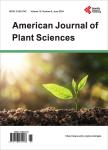Assessing the Efficacy of Wheat-Soybean Based Intercropping System at Different Plant Densities in Bambili, Cameroon
Assessing the Efficacy of Wheat-Soybean Based Intercropping System at Different Plant Densities in Bambili, Cameroon作者机构:Department of Crop Production Technology College of Technology University of Bamenda Bambili Cameroon Department of Agronomic and Applied Molecular Sciences Faculty of Agriculture and Veterinary Medicine University of Buea Buea Cameroon School of Tropical Agriculture and Natural Resource Catholic University of Cameroon Bamenda Cameroon Department of Agricultural and Environmental Engineering College of Technology University of Bamenda Bambili Cameroon
出 版 物:《American Journal of Plant Sciences》 (美国植物学期刊(英文))
年 卷 期:2024年第15卷第4期
页 面:235-251页
主 题:Competitive Ration Land Equivalence Ration Intercrop Soybean Wheat
摘 要:Wheat is one of the most important cereals in the world, serving as a staple for millions globally. In the wake of the geopolitical crisis between Russia and Ukraine, it has become incumbent for many countries to invest in wheat production. Improving cropping systems for wheat production is paramount. Intercropping cereals with legumes has tremendous advantages. Therefore, this study was designed to optimize wheat production by intercropping it with soybean at different densities. Between March and August 2023, a randomized complete block design trial was conducted in Bambili, North West of Cameroon with treatments T1 (wheat monocrop at 200,000 plants ha−1), T2 (soybean monocrop at 250,000 plants ha−1), T3 (200,000 wheat and 125,000 soybean ha−1), T4 (100,000 wheat and 250,000 soybean ha−1), T5 (200,000 wheat and 250,000 soybean ha−1) and T6 (100,000 wheat and 125,000 soybean ha−1). Results revealed that growth parameters of wheat were not significantly influenced by monocrop or intercrop. The yield of wheat was significantly higher in the monocrop than the intercrop treatments, with slight variation amongst the intercrop treatments. Soybean yield was higher in the monocrop than in the intercrop, with no variations amongst the intercrop treatments. Only the land equivalence ratio (LER) for T5 was greater than 1.0. The competitive ratio for T5 was 0.54 for wheat and 1.90 for soybean, comparatively lower than the other monocrop treatments. Intercropping wheat and soybean at 200,000:250,000 ratio is recommended.



